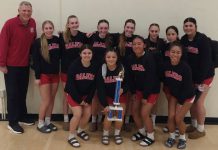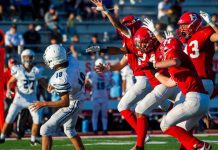Before I start getting hate mail from old-school golfers, let me
start this week by saying that Byron Nelson is one of the greatest
golfers of all time, a legend and a true statesman of the game.
Ken Venturi once said that there will always be debate over who
was the greatest golfer of all time, but that there will never be a
debate over who was the greatest gentleman that the game has ever
known. That man, according to Venturi and countless other golf
historians and pundits is Nelson, who is still alive and well at
the ripe old age of 94.
Before I start getting hate mail from old-school golfers, let me start this week by saying that Byron Nelson is one of the greatest golfers of all time, a legend and a true statesman of the game.
Ken Venturi once said that there will always be debate over who was the greatest golfer of all time, but that there will never be a debate over who was the greatest gentleman that the game has ever known. That man, according to Venturi and countless other golf historians and pundits is Nelson, who is still alive and well at the ripe old age of 94.
This past week, the PGA Tour made its annual stop in Irving, Texas for the EDS Byron Nelson Championship, which means that this is also the week that in addition to the 2006 tournament everyone reflected on Byron’s remarkable 1945 season.
We’ve all heard it. Even non-golfers have heard about that storied season, which included his records of 11 wins in a row that year, 18 total victories and his record scoring average of 68.33 that season – a record that held up for more than 50 years.
At first glance Nelson’s feats in 1945 seem almost surreal. In fact no one, not even Tiger Woods, will ever approach his 11 consecutive tournament win streak. But that doesn’t mean that there shouldn’t be a giant asterisk next to his feats in 1945.
For starters, in 1945 the Tour was a shell of itself that year as many of the top golfers of the time were sent overseas to fight in World War II. Nelson, a hemophiliac, did not have to serve in the military. As a result, the entire group of traveling professionals that year was about enough for several foursomes. And some events had even less players than that.
Sure Ben Hogan was around in 1945 but he didn’t play a full schedule and neither did Sam Snead that year.
Another fact that is out shadows the previous point is that several of Nelson’s victories during the famous streak were in two-man team events, one was in a four-ball event – which means that nearly half of those wins that year can’t only be attributed to Nelson’s stellar play. Some of it has to be attributed to the solid play of his partners.
Granted, he was the best player in the world that year but he didn’t get all of those wins as a result of his own play. Surely, his partners helped him a long the way with a clutch birdie here and there. As far as I’m concerned, that tarnishes the entire achievement.
Golf is an individual game, not a team game. Sure we have the Ryder and President’s Cups but they are unique formats that don’t come around too often.
In 1945 many events were set up more like exhibitions because it wasn’t as structured as it is today. In fact, many different formats were allowed. The PGA Tour wasn’t even officially established yet. The Tour was still for the most part a group of wealthy men who had enough money to travel around and play golf under the guidance of the Professional Golfers’ Association of America. Anybody could play the Tour back then if they had the money to do so. There was no Q-School.
During the era and even several years before my grandfather was a club professional in New England and when he had the time and money he played in a few events that are Tour events today.
I still have some of the old poster boards of exhibition events that he competed in – and many were against only a handful of pros. Remember, there were no jet engines back then and roads weren’t great. It might take a month for a pro to drive from the East Coast out to California to compete in the LA Open.
Most pros only competed in events no more than 100 miles from where they were from. Only the real wealthy players would travel the country to compete because the money was so minimal back then.
As a result, the talent pool was much thinner. There might have been just as many great players but they didn’t all have the means to get together to compete head to head other than a few times a year. Those events were the events like the Masters, U.S. Open and the PGA. There weren’t too many Americans heading to England to compete in the British Open back then either.
In 1945 the only Major that took place was the PGA.
The following year the war was over and the field got deeper and has every year since. But that doesn’t mean that Nelson wouldn’t be a top player if he were in his prime today.
Just this past week he said with a gleam in his eye when asked how he would stack up against today’s competition, “I wouldn’t starve out there put it that way.”
No he wouldn’t. Nelson achievements can’t be overlooked. He won 54 times on the Tour, including 5 major championships. From 1942 to 1946 he was in the top 10 in 65 consecutive tournaments. During the stretch he won 34 times. In 1945 he also shot 19 consecutive rounds under 70, which also can’t be overlooked.
Since Nelson’s storied season the only two players to even approach his mark of 11 wins in a row are Hogan and Tiger Woods. Both won six in a row. Woods did it twice.
While neither broke the record, they both did it alone, which should also have an asterisk next to it.









